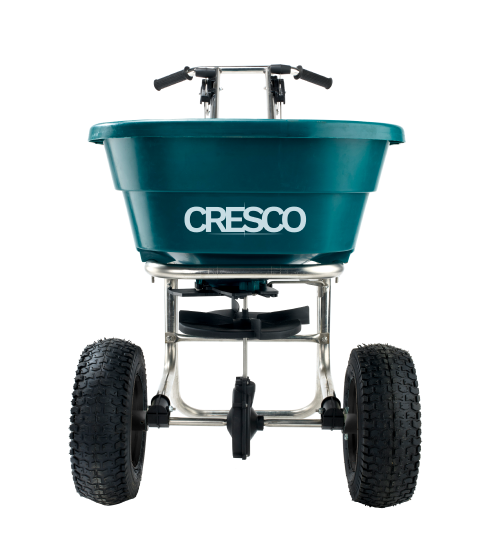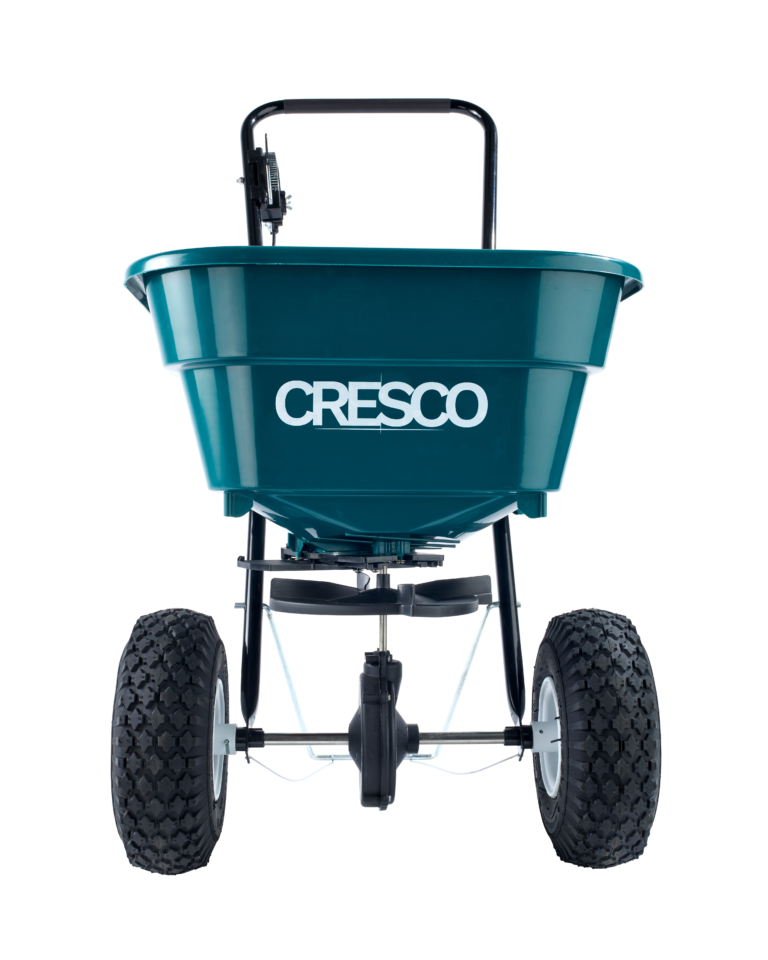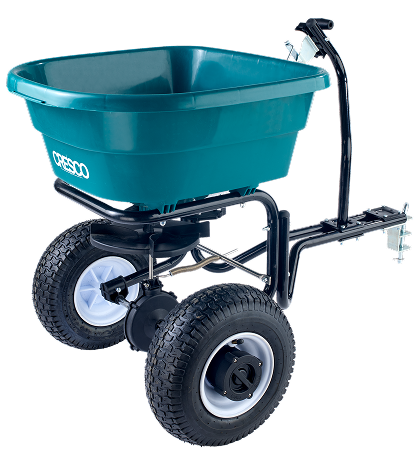The Use of Pedestrian Spreaders for Winter Maintenance and Gritting
What are Pedestrian Spreaders?
For the removal of snow during the winter season, there’s nothing that can beat a snowplow. Nevertheless, to get right down to the road or walkway surface takes more than a snowplow. And that’s exactly where pedestrian spreaders, otherwise known as manual spreaders come in handy.
It’s likely, since you’re reading this, that at some time in the past you’ve made your way, rather carefully, over a salt-covered sidewalk in the wintertime. You probably very much appreciated walking on a salted sidewalk rather than slipping on ice. But, the fact is, when road salt was first introduced to America during the 1800s, Americans were not exactly jumping with joy about it. The salt caused damage to shoes and clothing and made the streets completely useless for sleigh drivers.
Later on, city dwellers started to realize that salt when applied to ice and light snow as opposed to thick snow, was far more effective. Because snowplows would leave behind slippery layers of ice, city dwellers began to demand salt and sand for safer travel. Not long after, business owners and managers, as well as household residents, were throwing a plethora of salt over driveways and walkways during the winter months to ensure they remained ice-free.
Roadways and sidewalks were initially salted using shovels to remove salt from the beds of trucks; obviously, that was particularly back-breaking work.
Originally, towable spreaders were attached to trucks as a way of distributing fertilizer for agricultural purposes. These days, pedestrian and towable spreaders have been designed to efficiently distribute salt at high speeds and controlled flow rates.
Pedestrian spreaders and salt spreaders, in general, are now a crucial factor for household and winter road maintenance. On roadways, salt spreaders are very frequently utilized in conjunction with plows. The salt reduces the freezing point of water ultimately preventing the formation of ice.

What Exactly Can Pedestrian Spreaders Spread and How Do They Spread It?
Pedestrian spreaders, while they do not really appear to be, are, in fact, very versatile tools. You may only wish to use a pedestrian spreader in wintertime for salt or ice melt dispersal around your home. But the reality is that pedestrian spreaders can be used to spread more than just salt or ice melt. Like what, you’re wondering?
You can use a pedestrian manual spreader for seed sowing and for spreading fertilizer. Most pedestrian spreaders are up to this task, though it may take a bit of time and effort to get the adjustment of the control lever just right and there may also be a few other fiddly adjustments to be made as well.
Nevertheless, to avoid the hassles involved in making different adjustments, you can invest in a specialized pedestrian spreader. For instance, the Cresco 10SW or the Cresco 20SW. Both are engineered in such a way as to switch over from spreading salt to fertilizer (and vice versa) on a seamless basis. There’s no dismantling needed, no resetting or adjusting required on account of the unique Cresco Slide System Technology.
You may wish to use your pedestrian spreader to distribute feed grains such as birdseed, chicken feed, and oatmeal. Pedestrian spreaders are great for even dispersal, and because of that, at least in this case, using a pedestrian spreader for feed grain dispersal will not only save lots of time but it will save you money by reducing waste.
How do these machines spread?
Salt spreaders (or multipurpose pedestrian spreaders used in winter to spread salt) are particularly useful tools that can, and very likely do, save lives. They do, however, remain relatively overlooked, underrated, and not exactly completely understood in terms of their capabilities.
You can, providing you understand how to use one of these tools efficiently, save yourself a lot of energy, time, and money. Don’t be fooled by the misnomer. Salt spreaders can be used for so much more than clearing icy roads in winter.
So how do you use a pedestrian spreader for salt spreading in winter?
- Typically, ice melt and salt materials have a larger diameter than fertilizer pellets. On account of this, do be sure when salt spreading to open the manual spreader chute wider so that the material is properly distributed.
- Go slow! Walk slowly with your manual spreader so the salt doesn’t get launched all over the place.
- Consider investing in a drop spreader or a deflector to achieve optimal results. Deflectors help control and limit the spread of ice melt agents and this can protect your lawn and vegetation from undesirable distribution and potential chemical damage.
- Use the appropriate de-icing material. De-icing materials are unique because of the speed they achieve a desirable result and at the particular temperature they are most effective. The lower the temperature de-icing materials work and the more rapidly they achieve results, the more pricey they become. With that said it’s prudent to carry out some research and invest in one that works very effectively at the typical temperatures you experience in your area.
- Avoid using too much! Over-excessive application is not representative of something positive. So don’t be thinking, “Oh, I’ll add a little bit more ice melt than what’s recommended since that will surely get the job done all the better!” The overuse of ice melt will encourage the excess to be tracked inside, potentially damaging floors. Either this or you could burn your lawn. Read the packaging so you’re familiar with the appropriate quantity for your space.
- Plan ahead. If you’re aware of the approach of snowfall or an ice storm, an ice melt pre-application is ideal to avoid freezing. If, on the other hand, you’re unable to beat the storm, you’ll experience best results by making an application of ice melt just when snow begins to fall.
- When using your pedestrian spreader be sure to don appropriate PPE (personal protective equipment). Some ice melts contain magnesium chloride or calcium chloride. In which case, you must be sure to avoid skin contact as these chemicals can cause excessive dryness and potentially also skin irritation and burning.
- After completing the work, thoroughly wash the hopper out to avoid the corrosion of metal parts.
In What way are Winter Maintenance Spreaders a Better Choice for the Job in Comparison to Alternative Tools?
Generally, salt spreaders are simple to use. The material for dispersal is added to the hopper then the hopper releases the contents. During discharge of the material, it, the material, is spread evenly over the desired area by a spinning disk.
Salt Spreaders Don’t Necessarily Need to Have a Sole Purpose
Salt spreaders can ‘double up’ to combine other work. If the manual spreader comes with the option of a summer slider as well as a winter slider it can carry out numerous functions, including salt/ice melt spreading, fertilizer spreading, seed spreading, agricultural feed spreading, and more.
What Makes a Salt Spreader the Best Choice?
There are a variety of tools besides dedicated salt/ice melt spreaders that will help you to carry out the same job. Fact is, if the area you wish to cover is small, you can even salt-spread by hand. But for larger areas, there are a number of obvious benefits to taking the ‘ultra manual’ approach or rather than utilizing some alternative type of tool to try to achieve the same or a similar end result.
Pedestrian salt spreaders save you time and they also save a lot of effort and possible frustration Taking the manual approach to salting your driveway or sidewalk, or, for that matter, when spreading something else like fertilizer, well, it can be a mundane, tedious, effort-intensive, and inefficient procedure. Using a salt spreader, because it does save time and effort, allows you to spend more time doing other things. It will very likely also save money spent on ice melt/ salt due to highly efficient spreading capabilities.
Pedestrian salt spreaders perform the work at hand with ease. They distribute materials with a high level of accuracy and particularly evenly. Spreading manually, or relying on other types of non-dedicated spreaders can prove to be highly inaccurate and likely will mean an uneven spread.
With a dedicated salt spreader, there’s very little or possibly even no wastage of materials. Spreaders are accurate and many of them are fitted with features to limit the spread – again, leading to more accuracy.
Anyway, with this all said, if you wish to learn more about salt spreaders and how they can be of great benefit, please visit our comprehensive guide to salt spreaders.
Push Spreaders Available from Cresco
Cresco 10SW and Cresco 20SW
With more than 25 years of industry experience, Cresco has designed and built its product range from scratch to offer new technology, improved quality, and an expansion, which was much-needed, to the current pedestrian spreader market. Designed then manufactured with efficient and effective distribution in mind you’ll find that the product range from Cresco offers a no-compromise solution to the challenges faced in the current manual spreader market.
At Cresco, among the key goals was the creation of a manual spreader that was functional during the winter as well as in the summer (and possibly also well beyond).
However, due to the very sizable differences between salt and fertilizer or seed, a traditional push spreader is simply not up to the task. This is why Cresco introduced Slide System Technology. With Slide System Technology, which is a major part of the makeup of the Cresco 10SW and the Cresco 20SW, you can happily go about spreading salt during the winter months, then fertilizer or seed during the spring and summer months, and still enjoy a high-quality spread that is entirely hassle-free!
What’s the difference between the 10SW and the 20SW spreaders? It comes down to area coverage. We developed the Cresco 10SW for the typical homeowner – the homeowner that needs to cover an area of between 1,600 ft² and 5,400 ft². The Cresco 20SW pedestrian spreader, on the other hand, is far better suited to areas between 5,400 ft² and 37,700 ft².


